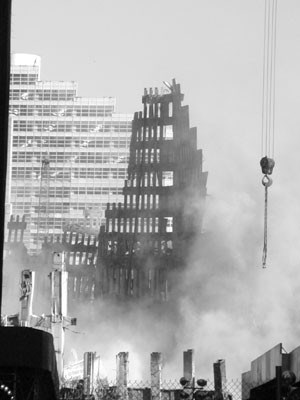The first thing you notice as you approach Lower Manhattan is the smell. It’s a toxic, burnt-metal stench that, mixed with the dust and ash still swirling through the canyons of the financial district, ensures Sept. 11 is never out of mind.
"It smells like Beirut," veteran CBS newsman Bob Simon has said.
Ground Zero, the site where the World Trade Center towers used to stand, is still burning, two months after the most carefully calculated and devastating terrorist attack in history. While world attention has moved on to the war in Afghanistan, airline bankruptcies, an insurance industry in crisis and general economic uncertainty – all to some degree effected by the Sept. 11 attacks – New Yorkers live and work around the giant, smouldering hole ripped in the city that day.
And they are living and working. Ground Zero is in danger of becoming a tourist attraction, now visited by every politician, dignitary, professional sports team and anyone else willing to travel these days. But New Yorkers for the most part are getting on with their lives. They are still grieving – there are 8 million people in New York City, millions more in the surrounding New Jersey, Connecticut area, and nearly everyone had some connection to the World Trade Center – but they’ve also adapted to the post Sept. 11 world faster than anyone else. The average New Yorker is probably less concerned about anthrax than is the average Nebraskan.
At Union Square on a Saturday afternoon in October, Hare Krishnas chanted and jangled next to the subway stop, while just a few feet away, standing on a milk crate, a speaker sounded off about U.S. policy in Nicaragua, to a sympathetic audience of six or seven. The speaker was partially drowned out by the sound of skateboarders tripping off nearby stairs and rails, and the ever-present honking of the New York cabbie’s horn.
At the other end of the square a band played some techno-feedback tunes at the Sonic Garden, just beyond the weekly farmers’ market where the freshest, lushest produce of the harvest season attracted shoppers.
New York stands as a living symbol to the entrepreneur and nearly every square inch of the city is available for advertising, at the right price. It’s no surprise to see NYPD and FDNY shirts and hats on sale at most street corners in Midtown. In Soho, a driver had plastered the windows of his truck with Osama bin Laden wanted posters.
At first glance, everything seems to be getting back to normal. If the British stereotype is a stiff upper lip and carrying on in the Queen’s name, New Yorkers will take your best shot and then be right back in your face. What baseball team but the Yankees has come from 14 games behind in September to win the pennant? What city had the foresight to build something as graceful and utilitarian as the Brooklyn Bridge before the automobile had even been invented? Where, amid often crippling poverty and racism, did jazz grow up?
But the world has changed – including the world of New Yorkers, who used to be reluctant to acknowledge that anything important could exist outside their city. From the hotel bellhop whose first words were "thank you for coming to New York," to the American flags plastered in nearly every store window and flown from every car antenna, things are different than they were before Sept. 11. New Yorkers been encouraged to get on with their lives, but some very fundamental assumptions have changed.
The massive, blocks-long lineup to get into Madison Square Gardens last month for a job fair organized for victims of the World Trade Center attack is one example. Thousands of people who worked in buildings surrounding the World Trade Center have been unable to return to work. The buildings, even if they weren’t physically damaged, are sealed off, full of toxic dust.
Others who survived the attack are trying to deal with the psychological impact of their survival, and of the deaths of friends and family.
Across the city National Guardsmen are stationed at the entrance to every bridge and tunnel, checking all delivery trucks. Precautionary evacuations of public buildings and schools are semi-regular occurrences.
But New Yorkers have also come together since Sept. 11, inspired by the stories of courage and sacrifice that came out of the World Trade Center attack. Demonstrations of compassion and concern for others – which existed prior to Sept. 11, contrary to many people’s perception of New York – can be found everywhere – on the subway, in the bars, on the streets. At the conclusion of most Broadway theatre performances a request for donations to the Sept. 11 Fund brings thousands of dollars each night.
And some New Yorkers are ready to begin rebuilding. There’s discussion about what should be done with the World Trade Center site once all the rubble is removed, but many are encouraging bigger plans, too. A new, spectacular Guggenheim Museum planned for the waterfront was put on hold earlier this year, but some people are saying now is the time to build it. Others are encouraging a bid for the 2012 Summer Olympics.
Soot and ash still emanate from Ground Zero, but there’s another fire in New Yorkers that refuses to be extinguished.




